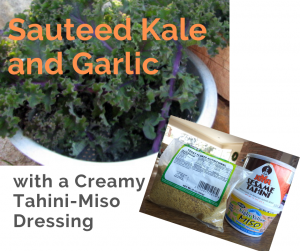
Late autumn is the time for kale. It’s a “cool weather crop,” which means that it tastes best when grown and harvested in cooler temps. However, even then it will still have a little of kale’s characteristically strong flavor. That’s why, no matter the season, I like to pair kale with the mild creaminess of a tahini sauce. The miso and nutritional yeast in the following sauce are great flavor enhancers, but both are optional in case you don’t have any on hand.
For the Tahini Sauce
½ cup tahini*
1 Tbsp. nutritional yeast (optional)*
1-2 Tbsp. lemon juice, to taste
1 tsp. honey
1 Tbsp. white or yellow miso*
Pinch to 1/16 tsp. cayenne pepper (or 1/8 to ¼ tsp. black pepper)
2 Tbsp. hot water, plus more as needed
Combine everything in the cup of immersion blender or bowl of food processor. Process in pulses to combine, adding more hot water, tablespoon by tablespoon (as much as ¼ to ½ cup), as necessary to mix thoroughly and achieve a consistency between tomato paste and tomato sauce.
Taste and add additional lemon juice, salt and/or cayenne (or black) pepper, to taste, being careful to add cayenne cautiously, shake by shake, tasting after each addition.
For the Kale
Stem the kale (reserving stems for another use), then tear or slice leaves into roughly 2″ square pieces. Simmer-Steam in a flavorful broth. When liquid is evaporated, push kale to sides of pan, add a little olive oil to the middle, and Low-Heat Saute 1-2 Tbsp. chopped garlic in oil. When fragrant, mix kale and garlic together, then stir in sauce, a couple tablespoons at a time, to taste.
Notes
Cooking Kale and Garlic In our cooking classes, we share the basic techniques for cooking greens and garlic. Once the fundamentals for Simmer-Steaming and Low-Heat Sauteing are learned, they can be done again and again, without referencing a recipe. This kind of “cooking from the hip” is what makes healthy cooking easy and manageable for busy home cooks. Please do join one of our live or online classes if this kind of instruction would be helpful.
Tahini is a thick paste made from ground sesame seeds. Find it in the refrigerated section or near the jars of nut butters. It usually separates and must be stirred well before using. Storing in the refrigerator is necessary to prevent it from becoming rancid, but the cold will cause it to harden. So remove a few hours before using and bring to room temperature, if possible, so it is easier to measure and mix.
Nutritional Yeast is used as either a condiment or ingredient to add a savory, cheesy, nutty taste to a myriad of dishes. Here’s a great primer on how this unique ingredient is made, is it nutritious, and also, can you overdose on it, who should consume it, and who shouldn’t.
Miso is a thick fermented paste made from soybeans that adds a rich, salty flavor to food. There are different colors of miso with flavor that ranges from less to more strong. The yellow or white miso called for in this recipe is the mildest and is sometimes called sweet miso. Here is a good primer on miso.
Extra Sauce Don’t worry if you end up with extra tahini sauce–it can be great on a variety of vegetables like green beans, broccoli and cauliflower and even on pasta dishes.